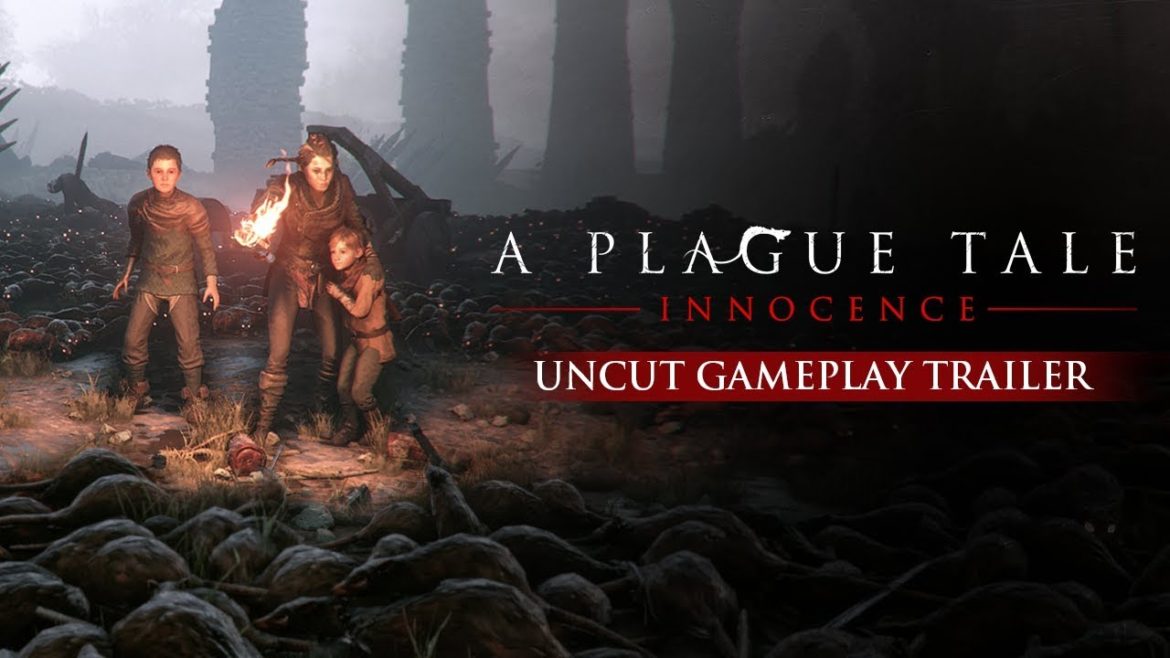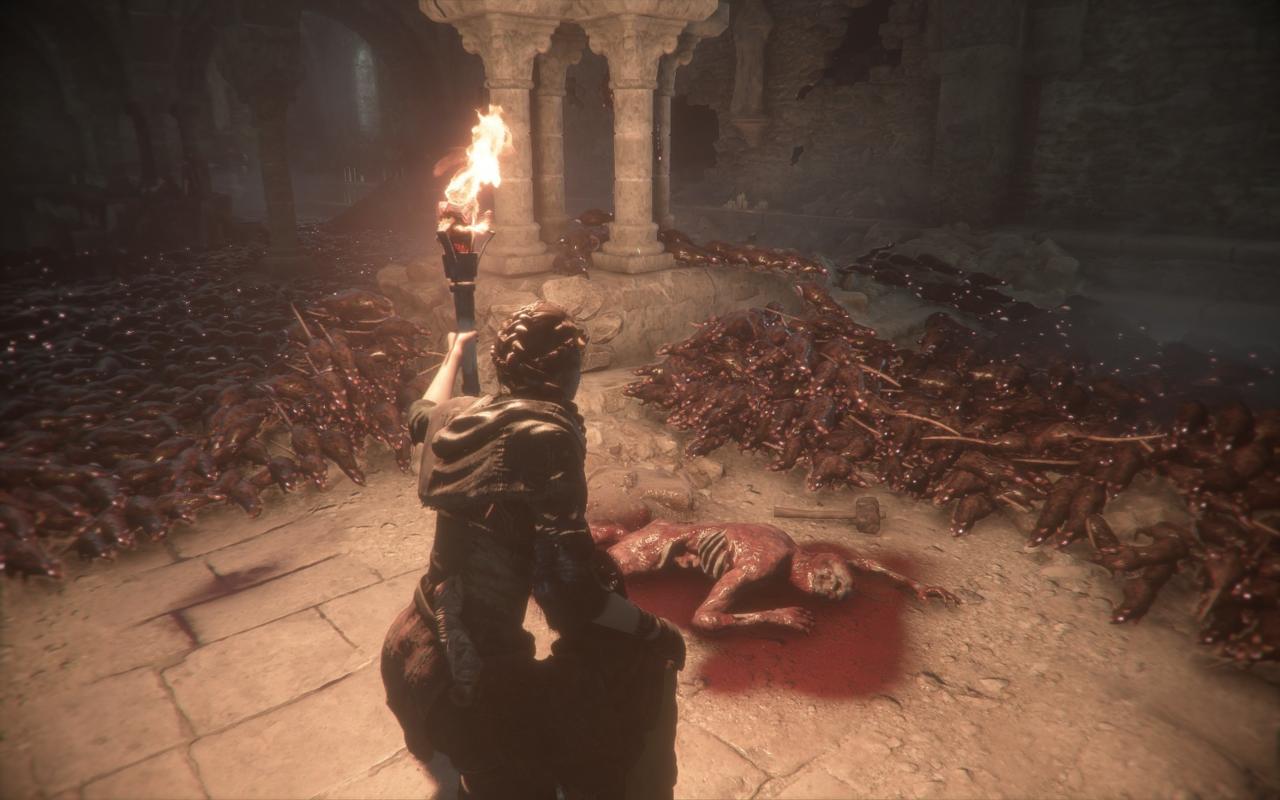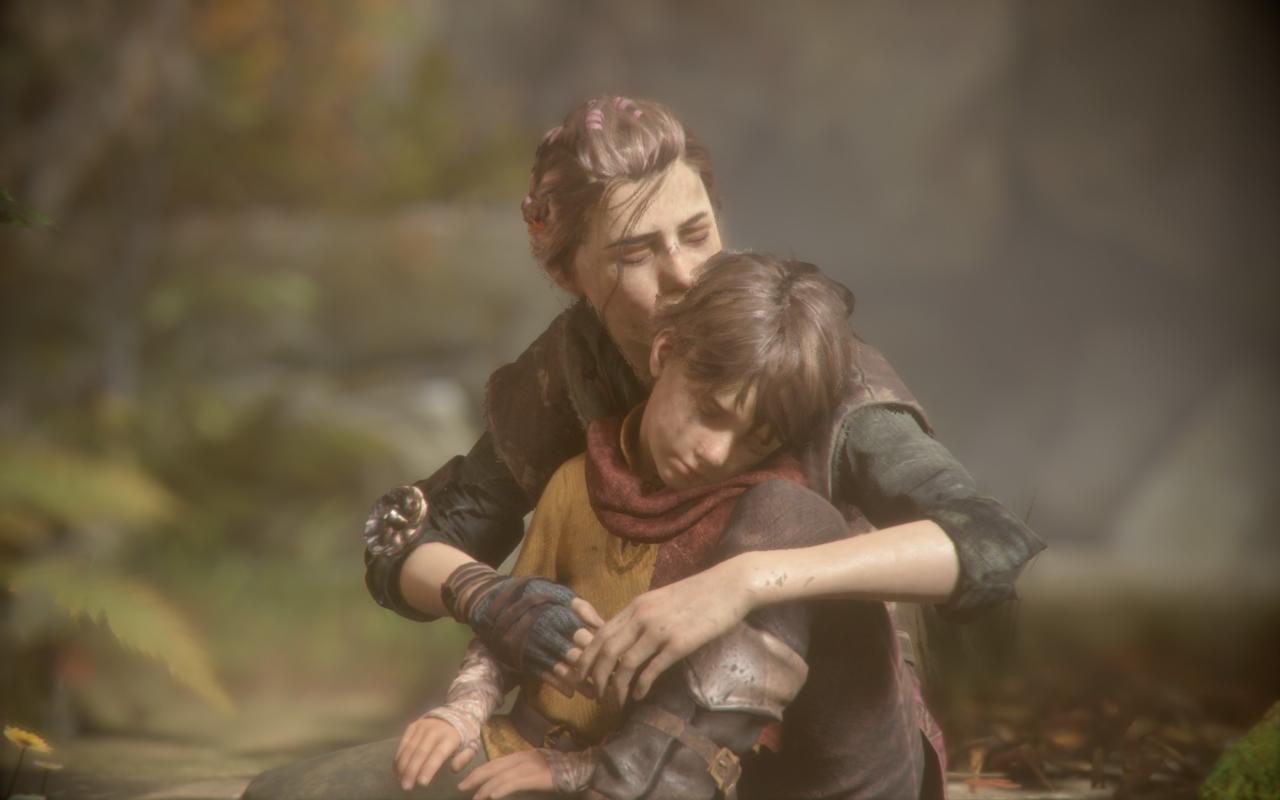
One of the most macabre scenes in A Plague Tale: Innocence is the eponymous plague, manifesting in the form of cursed rats. These vermin have a malevolent, otherworldly presence, their incessant screeching and scratching on stone pavements and atop piles of corpses making for a nightmarish, cacophonous din. Like sewage sludge, these creatures pour out of crevices towards their unwitting victims, ravaging them until they are just skin and bones. It’s an incredibly grotesque and spine-chilling sight–one that will linger in your mind hours later.
But even though the rats are a constant presence in Innocence, they merely serve as the backdrop for its more poignant moments, featuring the two characters you’ll spend the bulk of your time with: Amicia and Hugo de Rune, a pair of young siblings who are suddenly thrust into this hellscape of war and pestilence. Set amidst the Hundred Years’ War during the Middle Ages, the comfort the siblings once knew as children to a noble French family has been ruthlessly shattered. The Black Death, too, has wrought terror upon the country, with the bulk of the French population either dying from the plague or eaten by rats. Compounding this is the Inquisition, a fanatical group of knights keen to get their hands on the last of the de Rune descendants. Surrounded with sludgy pools of grimy rats, and with murderous knights hunting them down at every other turn, the duo need to gather their wits, leaning on stealthier means to escape from this mess. But not only do you have to navigate through the bedlam as the teenage Amicia, you’ll also have to take care of the five-year-old Hugo; he panics and shouts for Amicia when she ventures too far from him–as any young child will presumably do when surrounded by a neverending miasma of death and decay.










This arrangement does give Innocence the appearance of an elaborate escort mission, but fortunately, the game knows how to subvert the tedium that’s so typical of such games. A huge part is due to how human Innocence is. Despite his neediness and naiveté, Hugo is easy to grow fond of. His childlike wonder cuts through the wretchedness of their circumstances, allowing him–and helping Amicia–to appreciate the beauty even in the bleakest of times. In one scene, he quickly takes off to a nearby pier, fascinated by the curious sight of bubbles from frogs in the lake. Even a small gesture from him, such as plucking a flower–a symbol of tenacity in such trying times–to gently place it among Amicia’s braids, captures the warmth of their relationship. Such moments are heart-wrenchingly sweet, and you’ll share Amicia’s growing attachment to Hugo; his companionship is even greatly missed when she has to be paired up with other characters you meet along the way. On a mechanical level, it also helps that the artificial intelligence behind the characters isn’t hopelessly illogical, at least most of the time. Hugo isn’t usually one to chase after a butterfly in the thick of trouble, but the game still has its moments where a companion might accidentally take a kamikaze dive into a pool of quivering rats. Thankfully, these blunders are mercifully rare.
With survival being the thematic core of the game, Innocence is, at its crux, a series of survival puzzles; you’ll need to avoid the ravenous rat colonies, as well as evade the knights of the Inquisition. The rodents are terrified of light and will scuttle away at its mere presence–a weakness you can exploit to make your way across death-stricken battlefields and cities. Yet key to survival is also vigilance; wander too close to the rats, and they will attempt to devour you, clawing at the fringes of the light as their teeth chatter with insatiable hunger. And when a few stray rodents manage to latch onto you, Amicia can drown in a whirlpool of vermin, as they viciously and noisily gnaw on her. Few scenes in video games manage to be quite as eerie as this, heightening the game’s cloying atmosphere of despair and danger.
What’s decidedly less impressive, however, are the members of the Inquisition. As children, Amicia and Hugo won’t survive most direct confrontations with these armored brutes, who are only too eager to swing their cudgels and swords upon discovering them. Luckily for the de Rune siblings, the knights are also dumb as rocks; these barbarians are easily distracted by loud noises or sudden movements, such as by smashing a pot near their feet or tossing a rock towards a nearby chest full of armor. After staring at the offending object for a minute, the knight will mutter a variant of “Guess it’s just my imagination”–the most hackneyed and quintessential line used by hilariously obtuse NPCs in stealth games–and lumber back to their post, completely bewildered by the sound. In another far more egregious gaffe, another knight, while gawking at rats stripping his comrade to the bones, would grouse about the pointlessness of searching for his murderer, since they must be far gone by now. He then settled back to his programmed patrol, his back turned against the torrent of crazed rodents. For a game whose storytelling relies heavily on its atmosphere of dread and fear, such illogical instances absolutely butcher the mood.











That said, the game’s puzzles eventually ramp up in difficulty in later chapters, which renders combat and confrontations unavoidable at certain points. As dim-witted as the knights are, they’re still mostly decked out in heavy armor and weaponry–and can make devastating enemies. To compensate for her lack of brute strength, Amicia can modify and augment her trusty slingshot and ammunitions with the right materials and a dash of basic alchemy, turning the humble tool into a deadly and versatile weapon. Hugo isn’t a passive companion either; reaching cramped, hard-to-access places is his forte, and he’s gutsy enough to crawl through smaller breaches in walls alone to open up new paths for Amicia–provided the coast is cleared. Other characters, like a talented young alchemist named Lucas and a pair of orphaned thieves called Mellie and Arthur, will come with vastly different capabilities–and each with their own affairs to settle in this dire tale.
Scenes of desolation and tragedy mark Innocence’s dark, intriguing world, tied together with a narrative that’s genuinely moving without resorting to fetishizing the children’s sufferings. Despite their challenging situation, the siblings make do with what little help they get, bolstered by Amicia’s astounding resourcefulness, to survive this catastrophic mess. The game also magnifies the cataclysmic impact of the Black Death through a lens of cosmic horror, invoking the frightful atmosphere of H.P. Lovecraft’s macabre stories; the slithering rats, whether they are scurrying in the dank blackness beneath the city or trailing around half-eaten cadavers, never fails to be disconcerting. On the other hand, its villainous characters are almost painfully one-dimensional, with predictable twists and turns in the plot. This renders some of its revelations lackluster.











Powerfully ghoulish depictions of the plague and rats aside, Innocence is ultimately an emotive story of resilience against harrowing odds. The game’s title is an obvious nod towards the loss of innocence the endearing young cast faces throughout their journey. But more than that, it also speaks of the depths of human depravity and the agonizing cost of survival in the midst of war. Despite the unremitting horrors of Innocence’s beginnings, the game occasionally lets in a faint glimpse of hope. One of my favorite moments is when Amicia spots another wildflower in a lone trek across the city, nestled among the decay of the rats’ revolting nests. Without her brother around, she picks it up, and places it gingerly in her own hair–a personal reminder to keep trudging on amidst the hardships, and a testament to her growing strength and tenacity. Despite flashes of predictability, moments like these will bring a lump to your throat, as it did mine.



